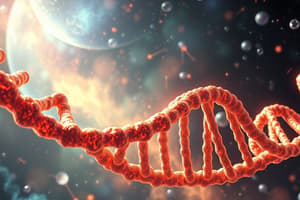Podcast
Questions and Answers
What is the main defining characteristic of probiotics according to the World Health Organization (WHO)?
What is the main defining characteristic of probiotics according to the World Health Organization (WHO)?
- They are suitable for any host species
- They consist mainly of bacteria and yeasts
- They are made by microorganisms
- They are administered in adequate amounts (correct)
How do probiotics help individuals who have undergone major changes in their normal microflora?
How do probiotics help individuals who have undergone major changes in their normal microflora?
- By directly killing harmful bacteria in the gut
- By genetically modifying the host's microflora
- By providing essential nutrients to the host
- By reestablishing the natural balance of gastrointestinal flora (correct)
What distinguishes probiotics from prebiotics?
What distinguishes probiotics from prebiotics?
- Prebiotics escape digestion in the upper gastrointestinal tract (correct)
- Probiotics are available for microorganisms living in the colon
- Prebiotics consist mainly of bacteria
- Probiotics are derived from plant sources
Why might a strain selected as a probiotic in one animal not be suitable for another species?
Why might a strain selected as a probiotic in one animal not be suitable for another species?
Which food does NOT naturally contain the prebiotic oligofructose?
Which food does NOT naturally contain the prebiotic oligofructose?
How are galacto-oligosaccharides mainly used?
How are galacto-oligosaccharides mainly used?
What is lactulose primarily used for?
What is lactulose primarily used for?
What effect does fermentation of oligofructose in the colon have?
What effect does fermentation of oligofructose in the colon have?
What is the term for the combination of prebiotics and probiotics in commercial products?
What is the term for the combination of prebiotics and probiotics in commercial products?
Why are probiotics used after a course of antibiotics treatment?
Why are probiotics used after a course of antibiotics treatment?
Which term best describes substances that are not considered probiotics, according to the World Health Organization?
Which term best describes substances that are not considered probiotics, according to the World Health Organization?
In which situation would probiotics be especially beneficial according to the text?
In which situation would probiotics be especially beneficial according to the text?
Why might a strain selected as a probiotic in one animal not be suitable for another species?
Why might a strain selected as a probiotic in one animal not be suitable for another species?
Which term refers to food ingredients that are available for microorganisms living in the colon?
Which term refers to food ingredients that are available for microorganisms living in the colon?
What distinguishes lactulose from oligofructose and inulin?
What distinguishes lactulose from oligofructose and inulin?
What is a key difference between galacto-oligosaccharides and oligofructose in terms of production?
What is a key difference between galacto-oligosaccharides and oligofructose in terms of production?
What sets synbiotics apart from standalone prebiotics and probiotics?
What sets synbiotics apart from standalone prebiotics and probiotics?
How do antibiotics differ from synbiotics in terms of their impact on gut health?
How do antibiotics differ from synbiotics in terms of their impact on gut health?
What is a distinguishing feature of probiotics compared to prebiotics according to the text?
What is a distinguishing feature of probiotics compared to prebiotics according to the text?
In what way do oligofructose and inulin differ from galacto-oligosaccharides?
In what way do oligofructose and inulin differ from galacto-oligosaccharides?
Flashcards are hidden until you start studying




